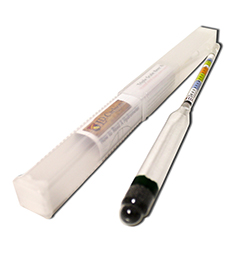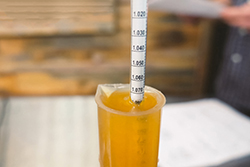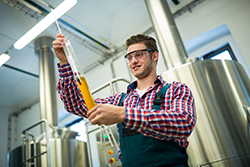The Hydrometer: Your Wine and Beer’s Fragile Fortune Teller
Posted by Matteo Lahm on 5th Jan 2024
Greetings, you passionate purveyors of pints and pinots! Today, let’s take a dip into the realm of hydrometers, those delicate glass marvels that assist us in concocting our perfect brews and wines. These fragile instruments, as you may know, have a knack for shattering at the most inconvenient times, but their importance in our craft is undeniable.
Without a hydrometer, there would be no way of knowing or predicting the alcohol content in wines and beers. This can lead to all kinds of problems, especially if you are working with recipes that require sugar additions. Too little sugar can result in flabby results with spoilage risks. Too much and your yeast will need a Xanax to relieve all the stress. It will struggle and eventually die leading to stuck fermentation, but not before leaving your wine or beer with a sulphur stench that will not be pleasant.
This little inexpensive tool is worth every gram of its weight in wine and beer. Without them, you'll be bobbing around like a buoy lost in a beer and wine sea.
History and Design:
Let's start by stepping into our time machine. The hydrometer, believe it or not, was invented in the late 4th or early 5th century by a brilliant Greek scholar ahead of her time, Hypatia of Alexandria. That's right! This essential brewing and winemaking tool has been around since the days when 'wine o'clock' probably meant a symposium with Socrates.
Hypatia’s hydrometer was a cylindrical tube, bearing a striking resemblance to a flute in size and shape. It was adorned with notches along a perpendicular line, a design feature that was far from decorative. These notches were the key to testing the weight of waters, a primitive yet effective method of gauging liquid density.

The concept of this device was deeply rooted in Archimedes' principle. This ancient Greek mathematician had discovered that a solid suspended in a fluid would be buoyed up by a force equal to the weight of the fluid displaced by the submerged part of the solid. Hypatia ingeniously applied this principle to her invention, allowing it to remain upright when placed in water.
The notches on the hydrometer could then be counted at one's leisure, providing a measure of the water's weight. This was the early precursor to our modern understanding of specific gravity. Hypatia's hydrometer was a testament to the ingenuity of ancient science, a tool that would evolve and endure through the centuries, playing a pivotal role in the art of brewing and winemaking.
Let's leap forward a few centuries from Hypatia's time, landing in the 11th century. Here, the hydrometer was utilized by the Persian scholar Abū Rayhān al-Bīrūnī. Known for his contributions to various fields, including astronomy, mathematics, and physics, al-Bīrūnī recognized the hydrometer's potential in his scientific endeavors.
The baton was then passed to Al-Khazini in the 12th century. Another renowned scientist of Persian origin, Al-Khazini made significant strides in the fields of physics and mechanics. His work with the hydrometer further solidified its place in scientific study and practical application.
Fast forward again to the 18th century. The saccharometer is the specialized type of hydrometer we use today. It was the brainchild of Thomas Thomson. This ingenious device was designed specifically to measure the sugar content in a solution, making it an indispensable tool for winemakers and brewers alike. It even found its way into the world of desserts, aiding in the creation of sorbets and ice creams.
The first saccharometer designed with brewing in mind was crafted by Benjamin Martin and was initially put to use by James Baverstock Sr in 1770. Its utility in brewing was later embraced by Henry Thrale and gained widespread popularity thanks to John Richardson in 1784.
The saccharometer is characterized by a large glass bulb, weighted and attached to a slender stem adorned with calibrated markings. To determine the sugar content, one simply needs to observe where the liquid's surface intersects with the scale on the stem. The principle behind this is straightforward: the higher the sugar content, the denser the solution, and consequently, the higher the bulb floats. So, in essence, the saccharometer is a floating sugar detective, helping brewers and winemakers perfect their craft. Now, let's unravel the mystery of how this delicate device works. It all boils down to Archimedes' principle. A solid suspended in a fluid will be buoyed up by a force equal to the weight of the fluid displaced by the submerged part of the solid. In layman's terms, the less dense the liquid, the deeper your hydrometer will sink.
The modern hydrometer is a marvel of simplicity and precision. It's typically made of glass and consists of a cylindrical stem and a bulb weighted with mercury or lead shot to make it float upright. The liquid to be tested is poured into a tall container, and the hydrometer is gently lowered into the liquid until it floats freely. The point at which the liquid touches the stem of the hydrometer is noted.
Reading Hydrometers:

Your contemporary triple scale hydrometer is a triple threat, boasting three different measurements: Specific Gravity (SG), Brix, and Potential Alcohol by Volume (ABV). Your hydrometer is designed to correlate all three of these scales which can be viewed simply by spinning it.
The Brix and Specific Gravity (SG) scales, two sides of the same coin, yet each offering a unique perspective on your brew or wine. Let's delve a little deeper into these two measurements and understand why they're both crucial to your brewing and winemaking process.
The Brix scale, named after the 19th-century German inventor Adolf Brix, is used to measure the sugar content in an aqueous solution. One degree Brix is defined as 1 gram of sucrose in 100 grams of solution. In the world of winemaking and brewing, this is incredibly important. The sugar content of your must (for winemakers) or wort (for brewers) determines the potential alcohol content of your final product. The more sugar, the more food for your yeast, and the higher the potential alcohol content. So, if you measure 25 brix in your must, that means there are 25 g of sugar per 100 g of solution.
On the other hand, Specific Gravity (SG) is a measure of the relative density of a liquid compared to water. In simpler terms, it's a measure of how heavy your liquid is compared to the same volume of water. This measurement is crucial because it gives you an idea of the amount of dissolved solids in your liquid, which, in the case of brewing and winemaking, are primarily sugars but can also include other soluble substances.
So why is it useful to know both? Well, while both scales give you an idea of the sugar content in your liquid, they do so in different ways. Brix tells you directly how much sugar is present, while SG tells you how much heavier your liquid is compared to water, which indirectly gives you an idea of the sugar content.
In essence, the Brix and SG measurements are like two detectives working the same case from different angles. They might approach it differently, but they're both crucial to solving the mystery of your perfect brew or wine.
As for the potential ABV, that measurement is a reference. It will not tell you the actual ABV of your wine by itself, but it will tell you the potential ABV based on measuring the sugars before starting fermentation. If your must or wort ferment dry, the scale will tell you your final ABV. If it does not, you will have to subtract the remainder from the original measurement.

Lastly, let’s delve into the curious case of the negative numbers on the Specific Gravity (SG) scale of your hydrometer. It's a bit like seeing a unicorn in the wild, isn't it? Well, let's unravel this mystery.
The SG scale is based on the density of water, which is set at 1.000 at 4 degrees Celsius (39.2 degrees Fahrenheit). Anything denser than water will have an SG greater than 1.000, while anything less dense will have an SG less than 1.000.
So, when your hydrometer dips below 0.000 on the SG scale, it's telling you that your liquid is less dense than water. But how is that possible, you ask? Well, it's all about what's dissolved in your liquid.
In the context of brewing and winemaking, the main things that can dissolve in your liquid are sugars and alcohols. Sugars are denser than water, so they increase the SG. Alcohols, on the other hand, are less dense than water, so they decrease the SG.
When you start your fermentation, your liquid is full of sugars, so the SG is high. As fermentation progresses, those sugars are converted into alcohol, and the SG drops. If all the sugars are converted into alcohol, the SG can dip below 1.000. In fact, dry wines and beers often have an SG below 1.000.
So, seeing a negative number on your hydrometer's SG scale isn't a sign of the brewing apocalypse. It's just telling you that your liquid is less dense than water, likely due to the presence of alcohol. It's a sign that your yeast has been hard at work, turning those sugars into delicious, delicious booze.
In conclusion, the hydrometer, despite its fragility, is a powerful ally in the hands of a skilled brewer or winemaker. Treat it with care, and it'll guide you in creating the perfect brew or wine. And remember, if you drop it, it's not a catastrophe. It's just an opportunity to buy a new one and perhaps a broom to clean up the mess.
So, raise your glasses to the hydrometer. May it always float to your expectations!

